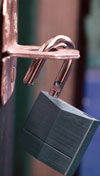Raising the alarmJuly 2009 If criminals are able to bypass perimeter defences, make sure your internal security systems are 100% reliable.
An effective intrusion detection or prevention system outside one’s house is crucial to the effective security of your family. What happens when they bypass all that and find a way into your home?
While there are many options when it comes to internal security, from alarms to cameras to beams and so on, in this issue of Home Security we will focus on alarms and newer camera and video technologies. We will offer more advice and insight into the various other options available in future issues.
A typical home alarm system comprises the following:
* A control unit. * Detectors or switches built into your door and window frames that sense when the door or window is opened. * Sensors with infra-red detectors, known as passives, to detect a presence in the room by sensing either motion or body heat. * A siren/alarm bell. * A panic button.
Most people understand the basic workings of an intruder alarm system. They know it has detectors, door contacts and a control panel that is usually connected to a siren located on site. They also believe that by connecting the system, via a standard telephone line, to a central monitoring station (CMS) that their premises are well protected. “Sadly this is an illusion” says Elvey Security Technologies technicians. “The reality is that such devices do not make the doors any stronger or the windows any tougher.”
Demystifying the alarms
There are many alarms on the market, each with different functions and different levels of protection. Many alarm panels are now so sophisticated they have numerous arming modes. For example, if you are ready to go to sleep, a simple press of a button on your control panel enables a pre-programmed function to kick in whereby your entire home is armed except your bedroom which is bypassed by the alarm. The same applies when you leave your home, pressing the away button means your entire home is automatically armed. 
Magnetic contacts: the most basic alarm
These are small magnetic contacts installed on the perimeters of doors and windows. If the magnetic contact is broken (ie, a door or window is opened), an alarm is activated. They are very common because they are inexpensive and they work. The contacts are not able to raise false alarms.
Passive infrared detectors
A passive detector focuses on a field of view directly in front of it and is activated when this field of view is intercepted. The interception is detected via temperature change in the passive’s field of view. A passive detector only receives information (ie it does not transmit anything). New technology has enabled cameras and passive detectors to be interlinked, thereby advancing the practice of integrating different security solutions into one single solution managed centrally.
Indoor pet friendly passive infrared detection is popular, allowing the detector to pick up human movement, but not that of small pets. This option is also very popular and reasonably priced.
Dual detectors: expensive yet very effective
A dual detector is a combination of a passive infrared detector and a microwave detector, merged into one single brain and is used in harsher environments such as a garage or warehouse. A microwave transmits and receives a signal all in one, whereas a passive infrared only receives, explains Andrew Stead, MD of ADI. Stead explains that the dual detector requires two signals to be activated before it goes into alarm mode, ie, an 'a' and 'b' is needed before the system goes into an alarm.
“This option is not as popular as it should be,” Stead says. “The most likely reason is that they are triple the price of basic passives, yet they should be better marketed by installers and alarm companies because they have successfully confronted the problem of false alarms. Unfortunately too many armed response companies do not advocate the need for having a high quality alarm that not only addresses false alarm issues but also works to more stringent controls.” Similar Articles
Related News
|

